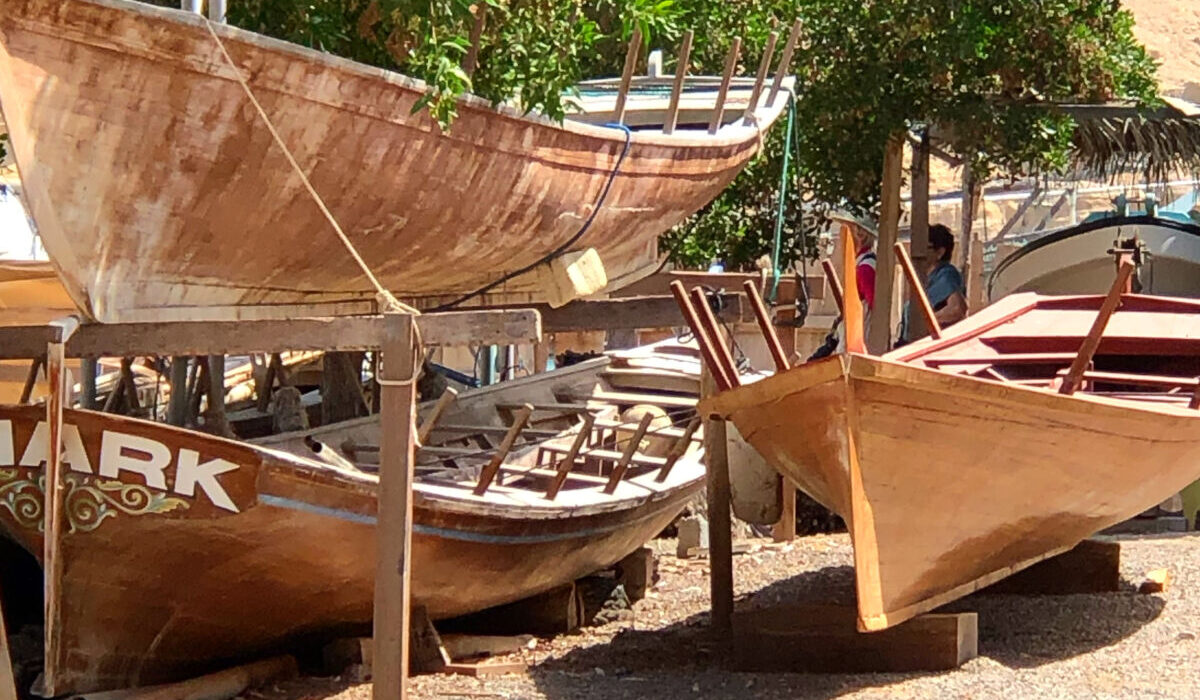It’s not surprising that Oman has been a major ship building country for generations. Surrounded by water on three sides, the Arabian country has depended on water for its livelihood for hundreds of years.
That’s all changed now, but dhows, the traditional wooden Arabian boat the country is famous for, is still in use.

A dhow is a generic name given to a range of traditional Arabian sailing vessels typically fitted with one or two masts and latreen rigging. Most modern dhows have motors.
https://en.wikipedia.org/wiki/Lateen

Oman is known to have the finest dhow builders in the world. These boats traditionally sailed from Oman to East Africa and India and China transporting spices and unfortunately slaves.
I visited the city of Sur on a Photo Tour in Oman in Feb. 2020 to photograph the last remaining dhow building yard. It was once one of hundreds along the coast of Oman during the peak periods of ship building. This tradition began in the 6th century, reaching a max during the 16-18th centuries.

First, we took a look at the harbor from a high spot seeing a couple of dhows anchored. Most had departed for a day of fishing.
Then we visited the Dhow Factory. The factory only produces one or two dhows at a time, typically for the tourist trade. They are made from Burma teak and ghaff, a local desert tree. They also restore older dhows.


Often traditional tools are used and blueprints are rare. The knowledge is in the heads and hearts of ship builders and passed from one generation to the next. They also make dhow models sold in the small store at the factory.


It takes about a year to build a boat for tourism. A simpler fishing dhow can be built in three to six months.
We didn’t visit, but I understand there is a terrific maritime exhibit in Muscat at the National Museum for folks who want to delve more deeply into Oman’s nautical life. We were happy to meander the Dhow factory cameras in hand
We also had a Dhow ride in Musandam.


Something that intrigues me is the legend of Sindbad the Sailor. I wish I had known about him on the trip, I would have asked guides if they believed in him. Kinda like Dracula in Romania. See last week’s post about Dracula for more about that interesting story.
The legendary Sinbad the Sailor either came from Oman or Bagdad. Some say he’s pure legend and didn’t exist at all. But if he come from Oman he most likely sailed from Sur.
According to Britannica.com: “Sindbad the Sailor, Sindbad also spelled Sinbad, is the hero of The Thousand and One Nights who recounts his adventures on seven voyages.
In the story, Sindbad is marooned or shipwrecked after he sets sail from Basra with merchandise. He is able to survive the terrible dangers he encounters by a combination of resourcefulness and luck and returns home with a fortune. Sindbad’s movement from prosperity to loss, experienced during a voyage filled with adventure, and back to prosperity, achieved when he returns home, is repeated in the structure of each tale.”
Source: https://www.britannica.com/topic/Sindbad-the-Sailor
Here’s a link for more about A Thousand and One Nights.
https://en.wikipedia.org/wiki/One_Thousand_and_One_Nights
A replica of the kind of dhow reputed to be sailed by Sinbad sits in a round-about in Muscat.
The organizer of this trip to Oman was Jim Cline Photo Tours.












Comments
1 CommentMargaret
Sep 28, 2020These boats are fascinating…and beautiful. Having had some years of experience sailing on your boat, I imagine you would have been interested to see one up close and to see the layout on the inside. Wouldn’t it be fun to tour on a dhow? I’m guessing it could be on your wish list.